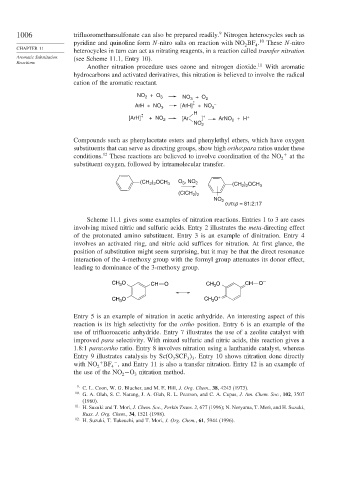Page 1030 - Advanced Organic Chemistry Part B - Reactions & Synthesis
P. 1030
9
1006 trifluoromethansulfonate can also be prepared readily. Nitrogen heterocycles such as
pyridine and quinoline form N-nitro salts on reaction with NO BF . 10 These N-nitro
4
2
CHAPTER 11
heterocycles in turn can act as nitrating reagents, in a reaction called transfer nitration
Aromatic Substitution (see Scheme 11.1, Entry 10).
Reactions
Another nitration procedure uses ozone and nitrogen dioxide. 11 With aromatic
hydrocarbons and activated derivatives, this nitration is believed to involve the radical
cation of the aromatic reactant.
NO + O 3 NO + O 2
2
3
.
+
ArH + NO 3 [ArH] + NO 3 –
. H
+
[ArH] + NO 2 [Ar ] + ArNO + H +
2
NO 2
Compounds such as phenylacetate esters and phenylethyl ethers, which have oxygen
substituents that can serve as directing groups, show high ortho:para ratios under these
conditions. 12 These reactions are believed to involve coordination of the NO + at the
2
substituent oxygen, followed by intramolecular transfer.
(CH ) OCH 3 O , NO 2 (CH ) OCH 3
3
2 2
2 2
(ClCH )
2 2
NO 2
o:m:p = 81:2:17
Scheme 11.1 gives some examples of nitration reactions. Entries 1 to 3 are cases
involving mixed nitric and sulfuric acids. Entry 2 illustrates the meta-directing effect
of the protonated amino substituent. Entry 3 is an example of dinitration. Entry 4
involves an activated ring, and nitric acid suffices for nitration. At first glance, the
position of substitution might seem surprising, but it may be that the direct resonance
interaction of the 4-methoxy group with the formyl group attenuates its donor effect,
leading to dominance of the 3-methoxy group.
CH O CH O CH 3 O CH O –
3
CH O CH O +
3
3
Entry 5 is an example of nitration in acetic anhydride. An interesting aspect of this
reaction is its high selectivity for the ortho position. Entry 6 is an example of the
use of trifluoroacetic anhydride. Entry 7 illustrates the use of a zeolite catalyst with
improved para selectivity. With mixed sulfuric and nitric acids, this reaction gives a
1.8:1 para:ortho ratio. Entry 8 involves nitration using a lanthanide catalyst, whereas
Entry 9 illustrates catalysis by Sc(O SCF . Entry 10 shows nitration done directly
3 3 3
−
with NO BF , and Entry 11 is also a transfer nitration. Entry 12 is an example of
+
2 4
the use of the NO −O nitration method.
2 3
9 C. L. Coon, W. G. Blucher, and M. E. Hill, J. Org. Chem., 38, 4243 (1973).
10
G. A. Olah, S. C. Narang, J. A. Olah, R. L. Pearson, and C. A. Cupas, J. Am. Chem. Soc., 102, 3507
(1980).
11 H. Suzuki and T. Mori, J. Chem. Soc., Perkin Trans. 2, 677 (1996); N. Noryama, T. Mori, and H. Suzuki,
Russ. J. Org. Chem., 34, 1521 (1998).
12
H. Suzuki, T. Takeuchi, and T. Mori, J. Org. Chem., 61, 5944 (1996).

